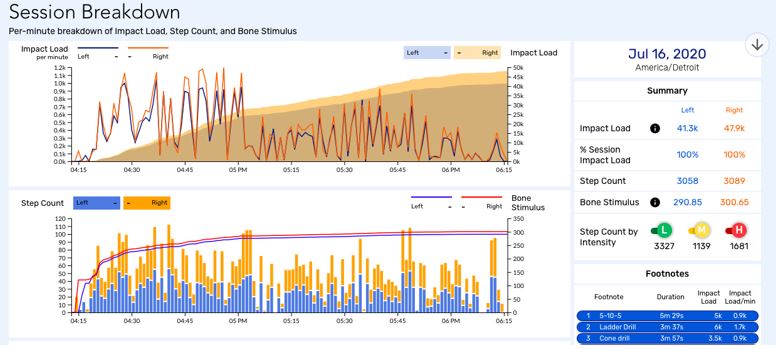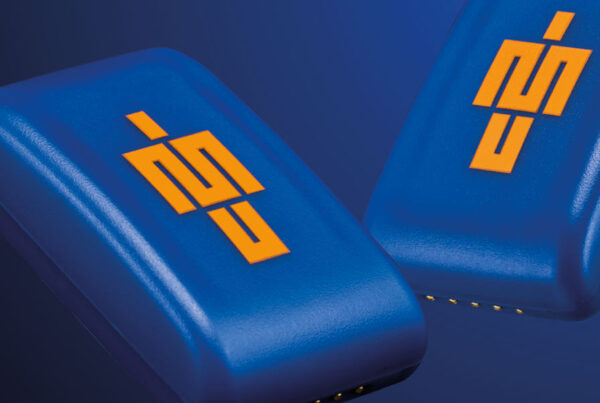Navigating the rehabilitation of an ACL injury is tough for everyone at the best of times. However not having athletes on site and being in lockdown due to a global pandemic makes it infinitely more challenging.
Prior to the outbreak of Covid-19, Connor Norman at the University of Georgia was managing an ACL rehabilitation program for one of his athletes. As soon as lockdown hit, Connor turned to IMeasureU to help him manage the rehab remotely.
“They were excellent to use from a remote standpoint as the athlete doesn’t have to interact too much with the interface for me to get the data. Plug in, hit download and within a few minutes I have the data to look at.”
Remote coaching
“We started using IMU Step almost as soon as we went into lockdown here in the US. As everyone was, we were separated from our athletes but it was essential that we continually progress our athletes through the return to play process. We were working closely with one particular athlete who had ruptured his ACL. We wanted to get him back running. With the use of IMU Step we were able to program for him completely remotely over those three or four months that we weren’t able to see him face to face.”
During the lockdown, Connor handed over the hardware to the athlete and left him in complete control of the sensors. With this in mind, data collection had to be quick and easy for the athlete to buy into the process. The cloud-based IMU Step system made this seamless and gave Connor immediate access to his athlete’s data each day.
“We’re fortunate here as we work with high level athletes and then they’re highly motivated but having this technology definitely helped with the accountability side of things. They were excellent to use from a remote standpoint. The athlete doesn’t have to interact too much with the interface for me to get hold of the data. Plug in, hit download and within a few minutes I have the data to look at.”

Figure 1: Early phase IMU Step data
“We wanted something that our athlete was able to use from a functional standpoint and that’s why we turned to IMeasureU and IMU Step“
Objective testing
Although the global pandemic did force Connor and the medical team at the University of Georgia to focus on remote monitoring, they also had another question. Were there gaps in their rehabilitation that IMU could help fill?
“The biggest question is how do we know when an athlete is ready? How do we know when we can, from an objective standpoint, put them safely back into play? We do a lot of objective tests in the athletic training room. However, once we get on the field and we’re doing functional activity, it becomes more subjective. We wanted something that our athlete was able to use from a functional standpoint. We felt that IMeasureU and IMU Step was the solution.”
Asymmetries, a crucial metric
“Limb symmetry is such a big deal to us. When I test somebody in the athletic training room when returning to play from an ACL injury, we first get them on the Biodex to investigate the hamstring to quadricep strength ratio and we compare left to right. As we progress through the rehab we go into more functional tests which include jump testing. Within that, we test a single leg hop and a triple hop for distance. These give us a marker of limb symmetry in the athletic training room. But in football, or any other sport, we need to be looking at activities and movements they are actually going to perform on the field and then look at the symmetry.
This is where inertial sensors at IMU Step comes in. They allow us to put a number to what we’re seeing on the field. They give us an additional, crucial layer of information in the RTP process to enable us to make better decisions.”
Asymmetries were a crucial metric that Connor and the team wanted more detailed information on. They wanted to track this over the course of the RTP process and use that information to inform programming.
“Initially we looked at just what the impact load was compared right to left, is the athlete able to control his surgical side as much as he has his non-surgical side and what does that look like over the course of a running session when we increase time? Does that difference between limb symmetry change even more dramatically if we make him go faster or go slower? As we progress through the rehab, we often will use the standardized NFL combine tests such as t-drill or the pro agility drill. This allows us to repeat the test and check progress.

Figure 2: IMU Step data during team activities during late phase rehabilitation
“That’s the extra layer of information during a rehabilitation that helps us to be more confident as we leave the athletic training room and move into the more chaotic environment of the field”
GPS and IMU-Step. Better together
Not only did the medical team at the University of Georgia medical team have access to IMU Step, they also had access to Catapult. This is Georgia’s 6th year with Catapult and they have accumulated baseline GPS data on all of their athletes. They came up with a system to take advantage of the baseline data they had on their ACL athlete.
“We’ve used catapult here for six years and catapult gives us some interesting external load data. We can see total yards, speeds and PlayerLoad. However, in conjunction with IMeasureU I can start to understand how they performed those yards. We had collected average PlayerLoad, maximum PlayerLoad and maximum speed numbers from our Catapult system. It was this baseline data that we used alongside IMU Step to guide progression. His average PlayerLoad was just over 500 for practice, therefore we were able to set percentages based on that. We were then able to see how asymmetry data provided by IMU Step was affected as we started to increase those PlayerLoad numbers back up to his pre-ACL injury levels.
During our initial investigation period, we had instances where we looked at the GPS data and saw that his PlayerLoad numbers looked like they were improving but when we overlaid the IMU Step data, we could see his limb symmetry was way off. That’s the extra layer of information during a rehabilitation that helps us to be more confident. We need that as we leave the athletic training room and move into the more chaotic environment of the field.”

Figure 3: GPS data data during team activities during late phase rehabilitation
As Georgia starts their football season, the athlete continues to make progress post ACLR as Connor and the medical team maintain their combined use of Catapult and IMU Step, overlaying them to create a very clear picture of what load the athlete is being exposed to. With this approach, they are more confident in their ability to ensure he returns to football safely.
Learn more
This case study builds on concepts we’ve explored in-depth at IMeasureU. Follow the links below to learn more –
How to Monitor your Athletes Remotely
Understanding External Biomechanical Load During ACLR Rehabilitation – A webinar with MArk Armitage
Managing the Mental Side of Injury During Quarantine
Have an injured athlete? Get in touch with us and ask about a free demo of IMU Step to see how we can help your return to play.


